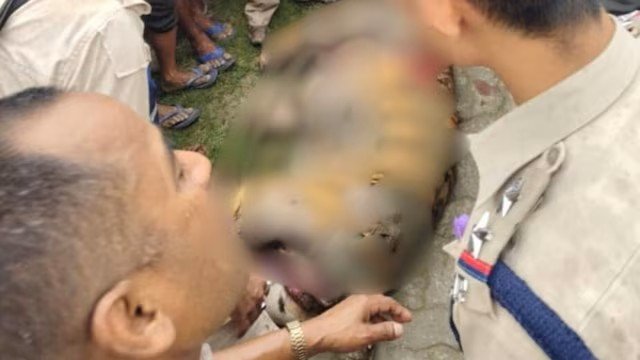
A mob killed a Royal Bengal tiger in Assam, sparking outrage among wildlife conservationists and officials. The tiger’s body was found mutilated, missing vital parts such as skin, tail, ears, and nails. The Assam police and forest department have launched an investigation into the case.
This unfortunate event highlights ongoing challenges faced by wildlife protection agencies in the region. The mob kills Royal Bengal tiger in Assam case is a grim reminder of the dangers that majestic animals face due to human-wildlife conflict and illegal activities.
Details of the Mob Attack and Discovery of the Tiger’s Body
The mob kills Royal Bengal tiger in Assam incident came to light when forest officials received reports of a dead tiger near a village in one of Assam’s wildlife buffer zones. Upon arrival, the team discovered the tiger’s body severely mutilated. Most of its skin was removed, along with its tail, ears, and nails.
Read More: S Phangnon Konyak Nagaland University Nomination Confirmed
These gruesome details suggest that the animal was targeted for its valuable body parts, which are often trafficked illegally for traditional medicine and trophies. Local authorities believe the attack was premeditated, and the mob may have killed the tiger to extract these parts.
The Assam Forest Department immediately alerted law enforcement agencies to investigate and bring the culprits to justice. The mob kills Royal Bengal tiger in Assam incident has raised serious concerns about poaching and trafficking networks operating in the area.
Wildlife Authorities and Police Response
Following the mob kills Royal Bengal tiger in Assam incident, both the Assam Forest Department and police intensified their efforts. Teams were dispatched to the area to gather evidence, interview witnesses, and identify those involved in the attack.
Authorities have appealed to villagers and local communities to cooperate and provide any information that may help catch the perpetrators. They warned that killing protected wildlife is a severe crime under Indian law, attracting stringent punishments.
The Assam Chief Minister condemned the attack and called for immediate action against those responsible for this heinous crime. He also urged local residents to respect wildlife and support conservation efforts to protect endangered species like the Royal Bengal tiger.
The Impact on Tiger Conservation Efforts in Assam
The mob kills Royal Bengal tiger in Assam incident is a setback for conservationists who have worked hard to increase tiger populations in the region. Assam is home to several important tiger reserves, including Kaziranga National Park and Manas National Park, which provide safe habitats for these big cats.
Conservation projects have shown positive results over recent years, with rising tiger numbers in protected areas. However, such brutal incidents undermine these achievements and pose a threat to ongoing protection measures.
Experts warn that continued poaching and illegal wildlife trade could reverse progress and endanger the survival of tigers in Assam and across India. The mob kills Royal Bengal tiger in Assam case calls for strengthened patrolling, stricter law enforcement, and community awareness programmes.
Reasons Behind Such Brutal Acts
The mob kills Royal Bengal tiger in Assam incident likely stems from complex issues, including human-animal conflict and economic incentives. As human populations expand near forest areas, encounters with wildlife have increased, sometimes resulting in retaliation attacks on animals.
Moreover, the lucrative illegal market for tiger body parts encourages poaching and brutality. Parts like skin, bones, nails, and teeth are in demand for traditional medicine, ornaments, and status symbols, driving organized crime.
Officials note that poverty and lack of alternative livelihoods in some rural areas also contribute to such acts. Hence, addressing these root causes is essential for long-term wildlife protection.
Steps Taken to Prevent Future Incidents
In response to the mob kills Royal Bengal tiger in Assam tragedy, authorities plan to strengthen protection measures. These include increasing the number of forest guards, deploying technology like drones and camera traps, and enhancing intelligence networks to crack down on poachers.
The Assam government is also collaborating with NGOs and local communities to raise awareness about wildlife laws and the importance of conservation. Educational programmes aim to reduce fear and misconceptions about tigers and promote coexistence.
The police have promised swift legal action against anyone found guilty in the mob kills Royal Bengal tiger in Assam case. Such measures are necessary to deter future crimes and assure communities that wildlife safety is a priority.
The Role of Communities in Wildlife Protection
Local communities play a vital role in preventing incidents like the mob kills Royal Bengal tiger in Assam. Forest officials have encouraged villagers to become wildlife protectors and report any suspicious activities.
Community-based conservation models have proven effective in some parts of Assam, where locals participate in monitoring and protecting forests. Involving residents helps reduce human-animal conflicts and creates a sense of ownership towards preserving natural heritage.
The Assam CM and forest department have pledged to support community initiatives that balance development with wildlife conservation.
Conclusion: Urgent Need for Stronger Wildlife Protection in Assam
The mob kills Royal Bengal tiger in Assam case has shocked the nation and brought urgent attention to wildlife crime in the region. This tragic loss underscores the need for tougher laws, better enforcement, and enhanced community engagement to safeguard endangered species.
Assam, as a critical habitat for the Royal Bengal tiger, must intensify efforts to prevent poaching and illegal trade. Protecting these majestic animals is vital not only for biodiversity but also for ecological balance and future generations.
The Assam government, forest department, and local people must work together to ensure such brutal incidents never happen again. Only through united action can Assam secure a safe future for its tigers and wildlife.



